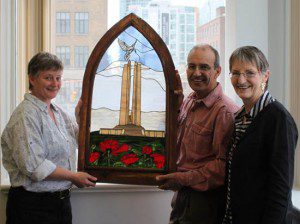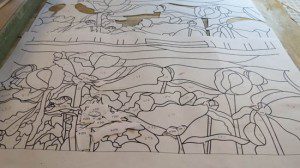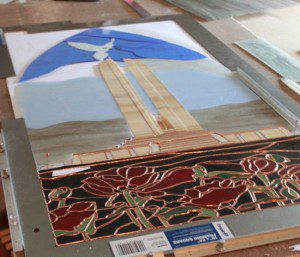
A few months ago, my wife and I were invited to a meeting in downtown Toronto. We thought it was about planning our European battlefield tour for next spring. So, we arrived at the Merit Travel agency on schedule. We were then escorted through a rabbit’s warren of office cubicles and into a boardroom and introduced to a member of the agency staff whom we didn’t know.
“This is Sue Parkinson,” we were told. “She’s got something for you.”
We shook hands. She handed us a card thanking us for the tour we had led earlier this spring to the battlefields of the First World War. Then, she directed our attention to the boardroom window. The window was tinted, but there was sufficient sunlight streaming through to illuminate a second window placed on the sill. It was stained-glass in what had once been a three-foot-high, old church window frame. The glass in her work showered the room with red, blue and green light depicting the historic Vimy Ridge monument. We were speechless.
I don’t know how most people acquire art. Often it’s the result of an impulsive purchase. Other times, with some sense of your taste in it, friends or family will purchase it for you as a gift. That can be dangerous. But on those rare occasions when both your sense of its beauty and the generosity of its being given to you as a gift coincide, a piece of art can become magical in your life.
Such was the case with this work by Ontario stained-glass artist Sue Parkinson at her Glass and Grind studio in Kingston. The gift originated with our colleague, Lori Copeland, at the travel agency. She wanted to offer us a token of thanks for our work on these tours. She had seen one of Sue’s previous works, called “Northern Lights with Pines” and hatched the idea.

“It had to be a memorial piece,” Parkinson wrote us in a note later. “And since the most visible memorial for Canadians is the Vimy Memorial, that was it. And poppies had to be present.”
With that idea in her head, back in January, she began working on the pattern – how she would depict the twin towers of the memorial, the stone base, the sky above and the ridge itself with the poppies. Several months after she began the work, the professionally prepared paper patterns arrived. She bought the stained glass locally, glued the pattern pieces to the coloured glass and began cutting the 300 or so pieces that would make up the final image.

With the pieces cut, she smoothed the edges, lined them with copper foil and soldered them together, much the way Louis Tiffany assembled his famous lampshades in 19th century Europe. The eureka moment came 70 hours of work later. Having created the piece flat on a table, Sue was finally able to lift the entire work and view it like a painting.
“When I saw it,” she admitted, “I didn’t want to give it away.”
The result, as I say, with the sunlight pouring through, is breathtaking.

Choosing art for your life is very much a gut instinct. My wife and I have purchased a few pieces of art that way. One was a piece of prairie art. It’s a large canvas with a single-dimension oil painting of a grain elevator on it. The painting is simple. It’s stark and big, the way grain elevators appear on the prairies. I’ve always had a fascination for the paintings of Charles Russell and Frederic Remington, who travelled – with sketchbook, brushes and paints on horseback – across what was the old American West. Very much like our own Lewis Parker, they captured moments of native life that I’ve always found riveting. But again that’s subjective.
Over the years my wife and I have purchased works by Jennifer Lawson, Ron Baird, Lynne McIlvride Evans, David Swinson and Megan Jones, Constance Laing and others – not just because we share their community, but because their work delights.
Until Sue Parkinson’s piece came to us, we’d never owned a piece of stained-glass art. I’ve always had an interest, particularly around Christmastime when Jim Curran, my broadcasting colleague at CBC Radio, created his pieces to raise funds for their Daily Bread Food Bank. Like Sue, Jim had a day job and worked evenings and weekends at his avocation. He admitted to several cuts from the glass over the years. But Sue said she’d been fortunate – no scars from her work.
On Sept. 15 and 16, this year, our Celebration of the Arts will stage its 27th annual Uxbridge Studio Tour, with artists opening their studios across the region. As usual, the tour includes the works of jewellers, blacksmiths, glass artists, ceramists, sculptors, painters, photographers, carvers, and printmakers among many others. It’s our annual opportunity to celebrate the quality of their work and to discover our own taste in art.
Sue is an artist who works from the soul and heart. Ted is blessed to have this magnificent piece of work. As someone who has been touched peronally by the Vimy Memorial, I want to say how this piece moved me personally. Thank you Sue for the beauty…and the tears…
There is a thing called serendipity and today I believe in it. I just came in from my studio and looking for a photo of the Vimy memorial to confirm a colour choice came on your post from 2012. I am Sue’s brother and am in the midst of redoing this piece, Sue loved this panel and always said if it had not been a bespoke piece she would have kept it. We talked often about what she would different or the same and I created a new pattern for her on my computer, we changed the mountains to sky so the memorial stands out more starkly and added to the foreground a flag pole and a waving Maple leaf flag. Sue died before she found a frame that she could then size the piece to fit. I started on this piece three months after but it was to soon and too raw and put it away in a drawer. Its now been just over two years since she passed, I am finally ready. There are now just over a hundred of the pieces cut and I came in to find a photo with a sky line to reference the colour and I found your piece. Thank you for the memory of my sister.